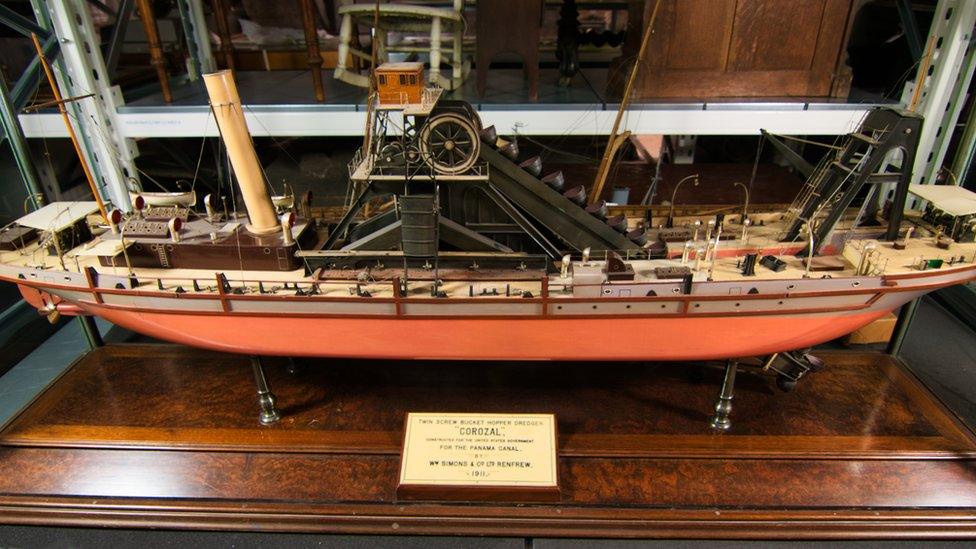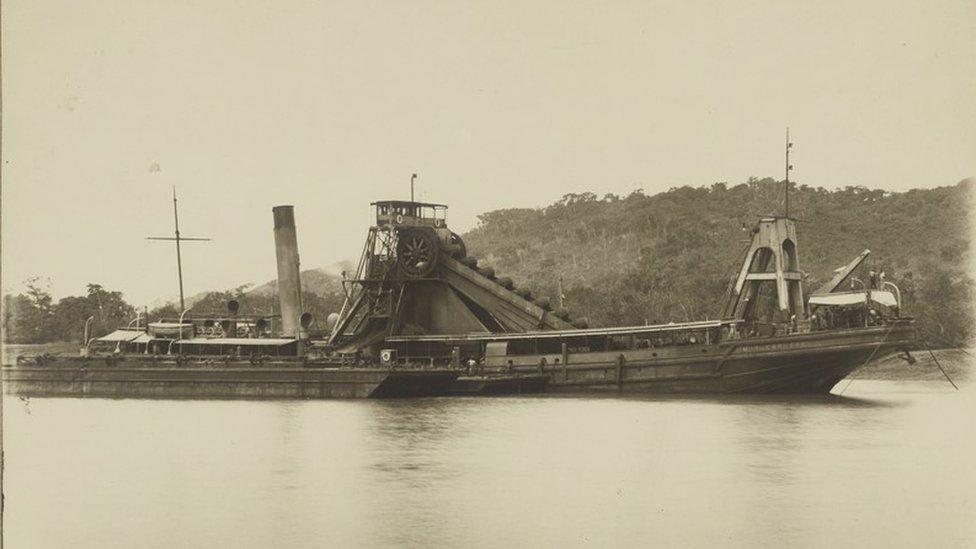The Corozal: Scottish dredger that helped build the Panama Canal
- Published

The Corozal dredger was built at Simon's shipyard in Renfrew on the Clyde
It was known as a wee ship that went a long way to do a big thing.
The Panama Canal is widely regarded as one of the 20th Century's engineering marvels and the Renfrew-built dredger, the Corozal, was instrumental in constructing what is often seen as one of its toughest and most dangerous sections.
Staff at Paisley Museum rediscovered a mislaid contemporary model of the ship when they were moving premises and it set them off researching a remarkable story which will feature prominently when the refurbished museum reopens in 2023.
"It's quite hard to picture when you see it now," says John Pressley of Paisley Museum, looking out across the Clyde to where the Simon's yard once stood. It is now covered by housing.
"Previously, this whole place would have been an absolute hive of industry - noise and smoke. They were building dredgers which pretty much helped to build the world," he adds.
"Building new harbours, new docks, expanding waterways, creating better trade routes."

A detailed model of the Corozal was discovered by staff at Paisley Museum
The United States began work on the Panama Canal in 1904, aiming to cut out thousands of dangerous sea miles between the Pacific and Atlantic Oceans.
As an American project the government there wanted equipment and material to come from America.
But it was a Scottish yard - Simons of Renfrew - which, in 1911, beat the competition with a bid which was less than half that of its San Francisco competitor.
The Corozal's job was leading the ships working on the Culebra Cut, which was a difficult section of the canal, prone to mudslides.
"It was the most powerful dredger that had ever been built," says Mr Pressley.

The Corozal (on right) in the Culebra Cut on Panama Canal in 1915
A workforce of about 18,000 had been chipping away with picks, shovels and dynamite and once a certain point was reached the Cut was flooded and the dredgers could come in.
"The Corozal then came in and did a lot of this excavation work," Mr Pressley explained.
"It was not there alone. I think there were about 33 other dredgers, which gives you an idea of the scale of the work they were carrying out."
A model of the Corozal from the time it was built was rediscovered when Paisley Museum staff were moving to a new store.
It shows in detail how it all worked; in effect a ladder of huge buckets to scoop out soil and mud.

A closer look at the model of the Corozal shows how the ladder system of buckets for scooping out soil operated

"There are these huge excavating buckets which could churn out tonnes of soil every scoop," says Mr Pressley.
"There's an amazing picture of one of these buckets in the shipyard and there's 12 men stuck inside.
"I think there's 50 buckets on that ladder so it really could churn out an awful lot of dirt and soil."
After it was finished in December 1913, the Corozal was the first ship to sail through the Culebra Cut, the last barrier to the canal opening the following year.

This image from 1911 shows the size of the huge buckets used to excavate dirt and soil
In its heyday there were yards for all kinds of ships along the Clyde; passenger vessels, liners, naval ships.
What happened on the river - including the Corozal - went worldwide.
"The Clyde was an absolute powerhouse of building," says Abigail McIntyre of the Scottish Maritime Museum.
"And the specialisms had this ripple effect around the world.
"So having a dredger being built on the banks at Renfrew it just proves how even some of the smallest yards could have such a big impact on the world stage."

The Corozal was the first ship to sail through the Culebra Cut when it was completed